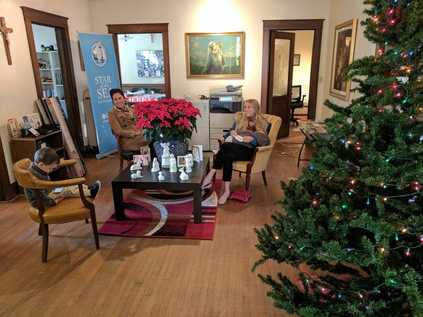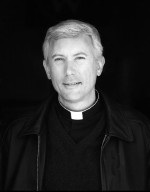 Our parish office is getting to look a lot like Christmas
Our parish office is getting to look a lot like Christmas Today’s collect (opening Mass prayer) is also used as the conclusion of the Angelus: “Pour forth, we beseech thee O Lord, thy grace into our hearts….” Devotional prayers come from the Mass and return us to it. Have you noticed that those who pray devotions like the rosary and the chaplet of Divine Mercy regularly, regularly go to Mass, while those who give up on novenas and litanies and daily prayers like the angelus eventually give up on the Mass. It’s vastly important for us Catholics to “take the Mass home” by praying these daily devotional prayers. One of my favorites is the Angelus, prayed three times a day, morning, noon, and night. You will hear the bells of our church, and many other churches, ringing the three sets of chimes at 6am, noon, and 6pm, calling all good people to pause and remember God’s blessings. The Mass for the fourth Sunday of Advent provides us the Angelus prayer, portraying an arch, so to speak, from the first Coming to the Second Coming of Christ. Let’s look a bit more closely at the Angelus prayer:
“Pour forth, we beseech Thee, O Lord, Thy grace into our hearts; that, we, to whom the Incarnation of Christ, Thy Son, was made known by the message of an angel, may by His Passion and Cross be brought to the glory of His Resurrection.”
St. Joseph
While Luke’s description of Jesus’ birth (which we will hear in two years) relates the Incarnation through Mary’s eyes, Matthew’s gospel (lectionary Year A) shows us the Incarnation through the eyes of St. Joseph. Isaiah had prophesied 500 years previously that “the virgin shall conceive and bear a son, and call him Emmanuel.” The same angel (Gabriel) that spoke to Mary speaks also to Joseph: “Joseph, do not be afraid to take Mary as your wife … that the prophecy might be fulfilled ‘the virgin shall conceive…’ When Joseph awoke,
he did as the angel of the Lord had commanded him and took his wife into his home.” Not only Mary, who was immaculate, but Joseph too, who like us labored under original sin, can trust the angel enough to do what God asks. “Pour forth, we beseech thee, O Lord, thy grace into our hearts,” that we may stay very close to Jesus, like his holy mother, so as to see the glory of his (and our own) resurrection.
Facing East
Finally, a word about how we pray at Mass. As you know, all of us pray to God facing the altar and tabernacle—facing his symbolic and real presence in this church. This is called “facing East” or ad orientem. Everyone faces God’s presence, that is, except your priest. In the current practice, when I pray to God I turn my back on the tabernacle, high altar, and crucifix. This parish is a big bus driving to heaven, and the driver of your bus, so to speak, faces his passengers while he steers us through the Eucharistic prayer. Many church leaders suggest we return to the traditional practice of facing east when we pray—all of us, priests and people together. When Mary and Joseph received the angel’s message, they faced him, and when they said yes to God, they looked to him to save them from death. Beginning this Ash Wednesday, I hope to try ad orientem worship for a few months at our parish. It will help our faith, I think, to look directly at Him in whom we put our trust.


 RSS Feed
RSS Feed